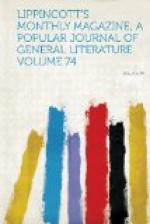[Illustration: ROTUNDA OF THE VIENNA EXPOSITION BUILDING, 1873.]
Perhaps in all this solid work the demands of time had not been duly considered. Certainly, the display was not punctual to the appointed period of opening. Exceptionally bad weather was another drawback, and the greed of the Viennese hotel-keepers a third. For such, among other reasons, the enterprise was financially a failure—a fact which little concerns those who went to study and learn, and those who three years later have to describe. If the darkening of the imperial exchequer prove more than a passing shadow, and an ultimate loss on the speculation cease to be matter of question, the few millions it cost may be recovered by the disbanding of a regiment or two. For one brigade, out of half a million soldiers, to bring the world and its wealth to the seat of government, is doing better than the usual work of the bayonet.
The country and the city themselves were a study to foreigners in many of the modes of life. The extent to which the utilization, as stationary and locomotive machines, of pigs, cows, women and dogs was carried elicited constant remark from the Western tourists, with sundry moral conclusions perhaps too hastily arrived at. This outside feature of the exposition may serve as an admonition to put our own surroundings in order. They are not apt to expose us to such comments as naturally occur to those who have never seen dogs and damsels in harness together; but other vulnerable points may peradventure be descried. We must demonstrate our civilization to be complete at all points, and not simply a coddled exotic under glass. What if our Viennese guests, physically a stouter race than we, should pronounce our women too obviously not hod-carriers, and painfully unaccustomed to wheeling anything heavier than an arm-chair or a piano-stool?
In that land of music concerts could not fail to be a leading feature. The Boston improvement of emphasizing the bass with discharges of distant artillery, or its equivalent, the slamming of cellar-doors nearer by, was not attained. Noise and harmony were kept at arm’s length apart.
The illustration of homes was made a specialty. As at Paris, the peoples brought their dwellings, or, more often, the dwellings came without their occupants. The four-footed and feathered live-stock were of more indubitable authenticity. The display of all the European breeds of cattle and horses—English Durhams, Alderneys and racers, Russian trotters, Holstein cows and Flemish mares, the gray oxen of Hungary and the buffaloes of the Campagna, the wild red pigs of the Don and the razor-backs of Southern France—was calculated to amuse, if but moderately to edify, our breeders of Ohio, Kentucky and New York. A thousand horses and fifteen hundred horned cattle comprised this congress, while two hundred and fifty pigs were deemed enough to represent the grunters of all nations.




